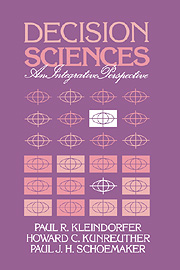3 - Prediction and inference
Published online by Cambridge University Press: 05 June 2012
Summary
Understanding decision making
It is not clear that we can ever fully understand the processes of judgment, evaluation, and choice. As John F. Kennedy once remarked:
The essence of ultimate decisions remains impenetrable to the observer – often, indeed to the decider himself. … There will always be the dark and tangled stretches in the decision making process – mysterious even to those who may be most intimately involved. (From Sorensen, 1963)
Indeed, being a good decision maker does not imply that a person necessarily understands his or her decision process. For example, most of us know how to ride a bicycle; however, it may be difficult to verbalize or teach this skill (which entails automated behavior) to others. With decision making and judgment, matters may be yet more complicated as we are trying to think about thinking itself. In the next three chapters we shall examine different phases of the problem-solving process as depicted in Figure 3.1. By imposing this framework, we will be able to gain considerable insight into the decision process itself, although some of its tangled stretches may continue to elude us.
The prediction and inference phase, to be discussed in this chapter, deals with the description of alternatives, in particular the formation of judgments and beliefs with respect to possible outcomes. Our concern in both this chapter and the next is with the descriptive and prescriptive aspects of problem analysis.
- Type
- Chapter
- Information
- Decision SciencesAn Integrative Perspective, pp. 67 - 114Publisher: Cambridge University PressPrint publication year: 1993



